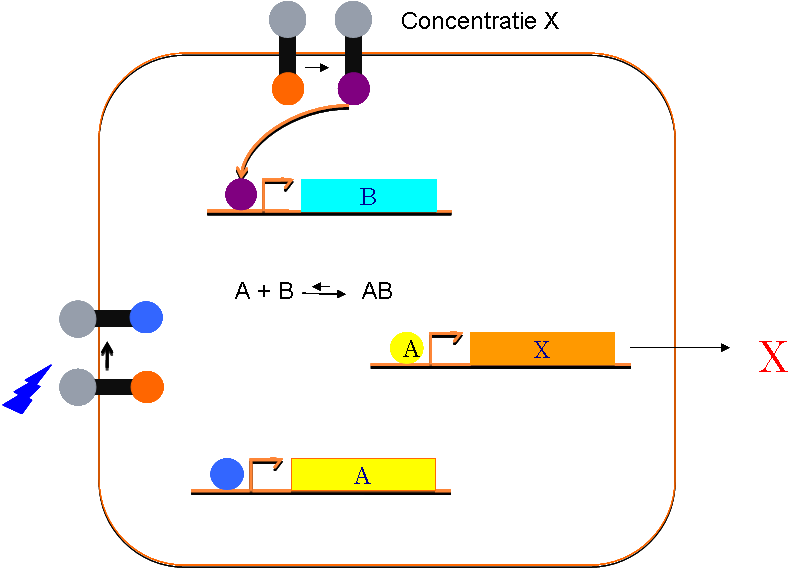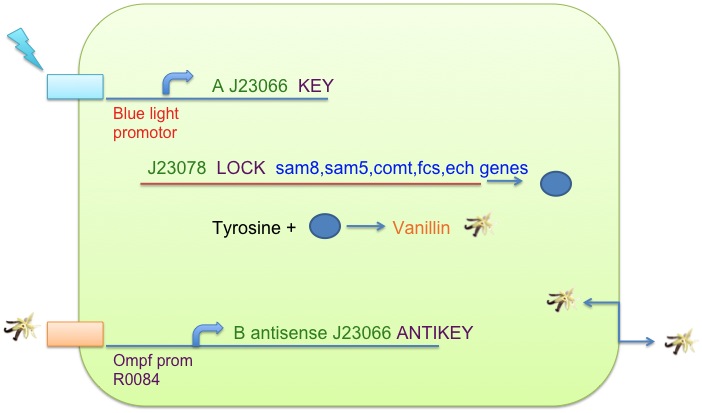Team:KULeuven/Abstract
From 2009.igem.org
(→How it works...) |
(→How it works...) |
||
| Line 20: | Line 20: | ||
'''Feedback control system''' | '''Feedback control system''' | ||
| - | The novelty of this project is a unique control system that functions through a feedback mechanism. The desired value of an odour like Vanilla can be adjusted using the intensity of a blue light beam. Essencia Coli then senses the concentration of the odour molecule and activates the inhibition mechanism of an anti-key. In this way | + | The novelty of this project is a unique control system that functions through a feedback mechanism. The desired value of an odour like Vanilla can be adjusted using the intensity of a blue light beam. Essencia Coli then senses the concentration of the odour molecule and activates the inhibition mechanism of an anti-key. In this way the concentration can be kept constant at any initially set point. |
| - | This concept can also be applied to other odours or even flavours. In theory, any molecule that acquires a constant | + | |
| + | This concept can also be applied to other odours or even flavours. In theory, any molecule that acquires a constant value is a possible candidate. | ||
'''Vanilla synthesis''' | '''Vanilla synthesis''' | ||
| - | To produce the odour of Vanilla, Essencia Coli synthesises Vanillin. This molecule is derived from the amino acid tyrosine, in a process involving five | + | To produce the odour of Vanilla, Essencia Coli synthesises Vanillin. This molecule is derived from the amino acid tyrosine, in a process involving five enzymes. The successive transcription and translation of ''Sam8, Sam5'', COMT, ''fcs, ech'' leads to Vanillin, which then diffuses out of the cell. |
Revision as of 11:57, 28 July 2009
Essencia Coli
Abstract
Vanilla Perfume, the story of a control bacterium
‘Essencia Coli’ is a vanillin producing bacterium equipped with a control system that keeps the concentration of vanillin at a constant level. The novelty of the project is the feedback mechanism. Vanillin synthesis is initiated by irradiation with blue light. The preferred concentration can be modulated using the intensity of that light. At the same time the bacterium measures the amount of vanillin outside the cell and controls its production to maintain the set point. An additional advantage lies in the universal nature of the system. The concept can easily be applied to other flavours and odours: any application that requires a constant concentration of a molecular substance.
concept
How it works...
Feedback control system
The novelty of this project is a unique control system that functions through a feedback mechanism. The desired value of an odour like Vanilla can be adjusted using the intensity of a blue light beam. Essencia Coli then senses the concentration of the odour molecule and activates the inhibition mechanism of an anti-key. In this way the concentration can be kept constant at any initially set point.
This concept can also be applied to other odours or even flavours. In theory, any molecule that acquires a constant value is a possible candidate.
Vanilla synthesis
To produce the odour of Vanilla, Essencia Coli synthesises Vanillin. This molecule is derived from the amino acid tyrosine, in a process involving five enzymes. The successive transcription and translation of Sam8, Sam5, COMT, fcs, ech leads to Vanillin, which then diffuses out of the cell.
Blue Light
A key/lock mechanism opens the door to synthesis. The transcription of the 'key' gene commences when a beam of blue light hits the Blue Light Receptor, thereby activating the promotor. The intensity of the beam can be adjusted at will. The 'key' mRNA then interacts with the 'lock' and clears the road for RNA Polymerase to transcribe the five genes.
VirA/VirG Vanillin Receptor
Essencia Coli is equipped with the two component regulatory system VirA/VirG, derived from Agrobacterium tumefaciens. The VirA protein senses phenolic compounds -in this case Vanillin- and then transduces the signal through phosphate transfer to the VirG protein. VirG acts as a response regulator by binding to the upstream region of the anti-key gene and activating its transcription. The anti-key is the anti-sense mRNA of the key and therefore will block it after binding.
The main idea is to synthesize Vanillin and control the synthesis such that the concentration of Vanillin stays constant. The value of this concentration can be set by intensity of blue light. This concept however can be extended to other molecules that need to be kept at a certain concentration, this can be for example other odors or flavours or something completely different like essential nutrients or vitamins. In the figure on the right an illustration of the controlling mechanism is explained. In here Vanillin is changed to molecule 'X' because of it's universal charachter. In the figure the cell synthesizes molecule 'X' and at the same time measures the concentration of this molecule outside the cell and uses this measurement to control the synthesis and keep the concentration outside the cell constant. This concentration can then be modulated using light intensity.
For proof of concept the molecule 'X' is set to be vanillin, to extend this principle to other molecule all that is needed is a concentration dependent receptor. The light receptor will activate transcription of A on irradiation of blue light. This will stimulate synthesis of Vanillin. The concentration vanillin outside the cell is measured with a vanillin receptor. The activation of the vanillin receptor will result in transcription of B and blocks the actions of A. The activation of synthesis by A is done with a key/lock setup. The translation of the Vanillin synthesizing proteins need a key in order to translate, A will provide the key. Therefore upon irradiation of blue light the required proteins will be translated. The inhibition of A by B is done by translating an anti-sense mRNA of A, blocking the actions of the key. Thus, if the concentration of vanillin increases, the synthesis of vanillin-synthesizing proteins will decrease untill it stops completely.
The complete system with the corresponding biobricks can be seen below, as well as the biobricks which still need to be created from the genes (blue light receptor and vanillin synthesis)
 "
"

